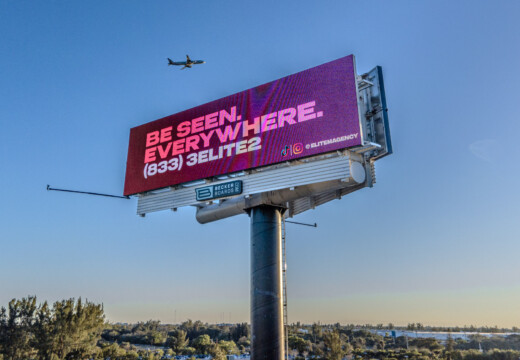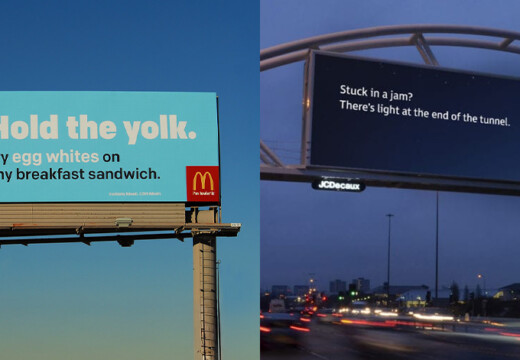Digital billboards combine LED screens with rotating ads, offering real-time updates and dynamic content. They’re cost-effective, flexible, and ideal for targeted messaging. Here’s what you need to know:
- Advantages: Update ads instantly, tailor messages to specific times, and share space to reduce costs.
- Location: Choose high-traffic areas with clear visibility and a matching audience demographic.
- Costs: Prices vary by location, time, and duration, starting as low as $10/day.
- Design Tips: Use bold colors, large fonts, and concise messaging (7 words max for headlines).
- Performance Metrics: Track impressions, website traffic, and audience engagement to measure success.
Digital billboards are powerful tools for reaching audiences quickly and effectively. Whether you’re running local promotions or building brand awareness, their flexibility and impact make them a smart choice.
The Ultimate Guide to Digital Billboard Advertising Costs
Location and Timing
Choosing Billboard Locations
Where you place your billboard can make or break your campaign. High-traffic spots like highways, downtown areas, and shopping hubs provide excellent exposure, but there’s more to it than just traffic volume. You need to think about several factors to ensure your billboard grabs attention and delivers results.
| Factor | What to Consider |
|---|---|
| Traffic Flow | Look for areas with slower-moving traffic, giving people more time to see your ad. |
| Viewing Angle | Make sure your billboard is positioned for clear visibility from key traffic routes. |
| Audience Fit | Choose locations where the local population matches your target demographic. |
| Unobstructed Views | Ensure your billboard isn’t hidden by trees, buildings, or other obstacles. |
Once your location is set, the next step is figuring out the best times to run your ads.
Timing Your Ads
Digital billboards give you the flexibility to display ads at specific times or under certain conditions. For example, you could promote lunch deals during midday hours or highlight holiday sales in December to match seasonal demand .
Platforms like Blip make it easy to schedule ads for peak times while managing costs with dynamic pricing. This lets you focus your budget on the time slots that deliver the most impact, ensuring you reach your audience when they’re most likely to engage.
Single vs. Multiple Locations
Should you stick to one prime spot or spread your message across several locations? The answer depends on your goals and budget. Here’s a quick breakdown to help you decide:
| Approach | Ideal For |
|---|---|
| Single Location | Local campaigns, limited budgets, or testing the effectiveness of your ads. |
| Multiple Locations | Building brand awareness, running regional campaigns, or reaching multiple markets. |
No matter which route you take, your billboard strategy should align with your campaign goals. Tools like analytics platforms and mobile data can provide insights into audience behavior, helping you make smarter decisions about where and when to run your ads .
Once your locations and timing are locked in, it’s time to focus on creating ads that truly stand out.
Costs and Returns
Digital Billboard Pricing
Digital billboard pricing can vary depending on your approach. For instance, platforms like Blip offer pay-per-play pricing, starting as low as $0.01 per display. Unlike traditional billboards that require long-term contracts, digital options allow for flexible scheduling.
Here’s a breakdown of common pricing models:
| Pricing Model | Description | Ideal For |
|---|---|---|
| Cost-per-thousand (CPM) | Pay based on estimated viewer impressions | Broad campaigns seeking maximum exposure |
| Fixed-rate | Pay a set price for specific time slots | Local promotions targeting specific audiences |
| Dynamic pricing | Rates adjust based on demand and time slots | Advertisers working with tight budgets |
While understanding pricing models is crucial, other factors can also affect your overall expenses.
What Impacts Ad Costs
Several factors play a role in determining the cost of your digital billboard campaign:
| Factor | Influence on Cost | Tip to Save |
|---|---|---|
| Location | Prime locations are more expensive | Focus on spots with the best reach for your budget |
| Traffic Volume | Higher traffic means higher rates | Consider areas with slower traffic for better visibility |
| Time of Day | Peak hours come with premium pricing | Schedule ads during non-peak hours for savings |
| Season | Holiday seasons drive up prices | Book early to lock in lower rates before demand spikes |
Measuring Campaign Results
To evaluate your campaign’s success, focus on these metrics:
| Metric | Measures | Importance |
|---|---|---|
| Impressions | Number of potential viewers | Confirms audience reach |
| Digital Attribution | Online activity increases | Tracks campaign-driven engagement |
| Dwell Time | How long viewers engage with the ad | Gauges ad appeal |
| Website Traffic | Spike in visits during the campaign | Indicates direct response to your ad |
"Digital attribution through uplift analysis and geofencing can provide valuable insights into campaign effectiveness and help optimize future campaigns" .
These metrics not only highlight how well your campaign performs but also help you fine-tune future efforts. Use the data to adjust your strategy – focus on the locations and time slots that deliver the best results. Combining billboard analytics with insights from other marketing channels gives you a full picture of your campaign’s impact.
Once you’ve nailed down costs and performance, it’s time to optimize your ad design for even better results.
Creating Effective Ads
Core Design Elements
Using high-contrast color combinations, like black text on yellow or white text on dark blue, makes your ad easier to read and more visually striking .
Here are the key elements for designing effective digital billboards:
| Element | Best Practice | Impact |
|---|---|---|
| Color Contrast | Bold, contrasting combinations | Enhances visibility and readability |
| Font Size | Large, clear typefaces | Ensures quick readability |
| Visual Hierarchy | One dominant element | Guides viewer focus |
| Brand Elements | Consistent logo placement | Strengthens brand recognition |
When combined, these design principles help your ad stand out and communicate its message effectively, even in busy, fast-paced settings.
Text Length Guidelines
Digital billboards follow the "3-second rule" – your message should be understood in the time it takes someone to pass by .
| Content Type | Maximum Length | Purpose |
|---|---|---|
| Headline | 7 words | Ensures quick comprehension |
| Secondary Text | 3-4 words | Reinforces the headline or call to action |
| Call to Action | 2-3 words | Encourages immediate action |
"The importance of inventing big ideas to attract consumer attention and drive action cannot be overstated in billboard advertising" – David Ogilvy .
Once your message is concise and clear, focus on visuals to make it even more impactful.
Image Selection Tips
Your visuals should complement and strengthen the message. High-resolution images and short animations can grab attention, but movement needs to be used strategically .
Guidelines for image selection:
| Image Type | Guidelines | Purpose |
|---|---|---|
| Static Images | Bold, simple visuals | Quick and effective communication |
| Animations | Keep under 5 seconds | Maintains viewer focus |
| Interactive Elements | QR codes, countdown timers | Encourages engagement |
One standout example is a campaign that adjusted visuals based on the time of day, making the content more relevant and engaging . Pairing well-chosen visuals with concise messaging ensures your ad leaves a strong impression on digital billboards.
sbb-itb-2e2e93f
Campaign Management
Tracking Performance
Keeping an eye on key metrics is crucial for understanding how well your campaign is doing. Combining both traditional and digital analytics gives a clear picture of its impact.
| Metric Type | What to Track | Why It Matters |
|---|---|---|
| Digital Response | Website Traffic, Search Activity | Highlights audience engagement and actions taken |
| Mobile Data | Foot Traffic, Device Presence | Reflects how billboards influence nearby behavior |
| Brand Impact | Social Media Mentions, Brand Searches | Shows the broader influence on brand visibility |
According to Nielsen, 65% of viewers take action after seeing digital billboard ads, such as searching for the advertiser online or visiting their website . Once you’ve analyzed these metrics, the next step is to ensure your content remains engaging and current.
Content Update Frequency
Updating your billboard content regularly is key to keeping it effective. No matter how well-designed an ad is, it needs periodic refreshes to maintain its impact.
| Update Type | Timing | Best Use Case |
|---|---|---|
| Daily Updates | Multiple times per day | Ideal for time-sensitive promotions or dynamic pricing |
| Weekly Rotation | Every 7-14 days | Works well for seasonal campaigns or brand awareness |
| Event-Based | As needed | Perfect for special promotions or limited-time offers |
Here are some strategies to make your updates count:
- Dynamic Targeting and Content Updates: Digital billboards can adapt to time of day, traffic flow, or audience demographics. With real-time data and automation, you can tweak content instantly – whether it’s adjusting inventory, pricing, or promotions across multiple locations.
- Performance-Based Optimization: Use insights from performance data like website visits or social media activity in billboard areas. This helps refine both the content and its scheduling for better results .
Platforms with pay-per-play pricing let advertisers make quick adjustments without being tied to long-term commitments, keeping campaigns flexible and responsive.
Marketing Integration
Supporting Marketing Goals
Digital billboards can amplify your marketing efforts by working hand-in-hand with other channels. When you align billboard ads with your broader strategy, your campaigns can deliver stronger results.
| Marketing Goal | Integration Strategy | Expected Outcome |
|---|---|---|
| Traffic & Engagement | QR codes, hashtags, and tracking links | Increased website visits and social media activity |
| Brand Awareness | Consistent visual branding | Better recognition across all platforms |
Platforms like Blip make this process simpler with tools like flexible scheduling and real-time updates. Their pay-per-play model lets you quickly tweak campaigns based on how they’re performing across other channels.
Cross-Channel Coordination
The success of integrated campaigns often depends on timing and consistent messaging. A great example is Coca-Cola’s "Share a Coke" campaign. They paired digital billboards featuring personalized names with social media contests and in-store promotions, creating a seamless experience across channels.
To make your cross-channel campaigns more effective:
- Schedule billboard ads to align with peak times for other activities.
- Keep messaging and visuals consistent across all platforms.
- Use data from each channel to refine and improve your overall campaign.
Driving Viewer Action
If you want viewers to engage, clear calls-to-action (CTAs) are a must. Nielsen data shows that 65% of viewers take action after seeing digital billboard ads. Make it easy for them to respond.
| Action Type | Implementation |
|---|---|
| QR Codes | Place prominently and link to mobile-friendly pages |
| Social Tags | Use simple, memorable hashtags across platforms |
| Special Offers | Add time-sensitive promotions with unique tracking codes |
For instance, McDonald’s used location-specific QR codes on their digital billboards to direct users to exclusive mobile app deals. This approach seamlessly connected outdoor advertising with digital engagement.
Conclusion
Key Points Review
Digital billboard campaigns thrive when specific factors are prioritized. Studies show that billboards with dynamic content and quicker launch capabilities often outperform their static counterparts . The ability to adjust messages in real time offers advertisers a powerful tool for more responsive marketing.
Four main elements form the backbone of effective campaigns:
- Choosing the right location and timing
- Using clear, high-contrast visuals
- Integrating with other marketing channels
- Continuously tracking and refining performance
Getting Started
Launching a digital billboard campaign can be broken down into three main steps:
- Planning: Identify your audience and pick billboard locations that align with traffic flow and audience demographics.
- Design: Develop ad content that’s simple yet impactful, keeping proven design principles in mind.
- Execution: Track key metrics and tweak your campaign in real time to maximize its effectiveness.
Platforms like Blip make it easier to manage these steps, giving advertisers control over their messaging and budgets. Regularly reviewing performance data helps refine strategies and improve ROI over time .
FAQs
How much does it cost to advertise on a digital billboard?
The cost of advertising on a digital billboard varies based on factors like location, duration, and timing. Through digital ad platforms, you can start as low as $10 per day for a 10-second display slot . For exclusive digital billboard space, monthly rates typically range from $1,200 to over $15,000 .
Several key factors influence pricing:
| Factor | Impact on Cost |
|---|---|
| Location & Market | Premium spots in cities or high-traffic areas come with higher price tags. |
| Display Duration | Longer ad durations mean higher costs overall. |
| Time Slot | Prime times, like rush hours and evenings, are priced higher. |
For example, billboards in locations like Times Square cost much more than those in smaller markets. But the increased exposure and engagement often make the investment worthwhile .
To make the most of your budget, consider targeting specific times, balancing high-traffic areas with more affordable locations, and sharing screen time with other advertisers . When evaluating ROI, think about both the direct costs and the potential reach of your chosen billboard spots .
Once you’ve got a handle on costs, focus on crafting a standout ad design and choosing the right placements for maximum impact.


